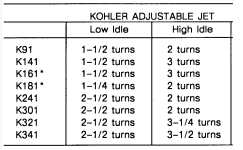It ain't the heat , it's hot everywhere - I've had over 100 degrees for 20+ days here and not seen anything like what you're describing and no one else is having this issue, it's something else in my opinion - Neve have I heard of gasoline boiling in a fuel tank
You are using an out of date browser. It may not display this or other websites correctly.
You should upgrade or use an alternative browser.
You should upgrade or use an alternative browser.
2023 Briggs & Stratton XR 13.5 - Bubbles in fuel...
- Thread starter jthrash
- Start date
More options
Export threadGord Baker
Well-Known Member
- Joined
- Aug 21, 2018
- Threads
- 1
- Messages
- 490
Wrap the fuel line in Tin Foil if you can. Be sure to route fuel lines as far as possible from Exhaust pipes. You may want to make a heat shield between the heat source and the tank. Sounds like old fashioned vapour lock. Drill a small hole in the cap before you become a fireball.
VRR.DYNDNS>BIZ
Well-Known Member
- Joined
- Jul 17, 2016
- Threads
- 1
- Messages
- 218
Most of the above is a good round up, but I have to add my most significant belief. Assuming the engine was running or recently shut down hot in your video, we have hot fuel boiling, or more commonly called vapor lock in a pressurized system like on cars. Since a gravity feed, two causes of vaporized fuel. One less impact on running is vibration excitation of fuel molecules in the tank crossing energy level to vapor and bubbling up and causing pressure in the tank which may overcome the venting capable. The hotter the fuel in the tank, the greater the problem or likely hood of this. The second bubbling is similar but does cause running problems. The same heat and vibrations of the fuel in the carb or fuel lines. Less likely is it occuring in the carb bowl or carb fuel passages. More likely is in the fuel lines. When in the lines, since we are talking gravity feed, fuel must flow down by gravity but bubbles of fuel vapor must rise. This causes fuel flow down to be greatly resisted by bubbles rising. That can stop flow into carb or not have enough pressure on inlet needle to overcome the float needle and limit fuel to the carb bowl or effectively change the design of the fuel level in the bowl which is to carb design and cause lean running or misfires. These bubbles will rise to the tank and will add to any bubbles created by the tank itself. To test this, a few things can help. Run with best cooling. Replace rubber lines as a temporary test with clear HIGH TEMP lines and insure they do not get hot and leak and catch fire! This allows the observation of bubbles in the line. Best first test is to add fuel that will not vaporize as easily with additives to help. Non ethanol fuel will help but may have as mush as 5% ethanol in it. Treat fuel with Lucas Fuel treatment in a green tall neck bottle. Add a fair amount of Marvels Mystery oil to the gas not quite as much as a 50 to one ratio but not less than 100 to 1. If these treatments lengthen the time it takes to re-create or eliminates the problem with nearly the same ambient temperature, it is vaporizing fuel problem. These fuel treatments can be used continuously if it solves your issue.Was the engine running when you took the video? I assume it was but I couldn't tell for sure. If so then the bubbles are normal and caused by engine vibration. Years ago manufacturers would put baffles in the fuel tanks to help limit that but then the baffles could deteriorate and plug the fuel outlet. If that video is with the engine not running, that fuel is getting a lot hotter than it ever should IMO.
As far as pressure in the fuel tank, that should never happen and enough pressure could cause carb flooding. That would make me think the fuel tank is not venting properly. From the parts breakdown it looks like the engine has a fuel cap with a carbon filter in it so as to not vent fuel vapors into the atmosphere. That's pretty common these days on engines with fuel tanks mounted on them. Typically those types of caps have a tether on them. If that's the case then replacing the fuel cap should eliminate the pressure you're finding when you remove the cap.
The fuel tank should be designed to keep the fuel level low enough so it doesn't contaminate the fuel cap but with a little effort you can fill the tank all the way up into the filler neck. If those carbon filter fuel caps get fuel in them that can deteriorate the carbon and plug the vent.
Attachments
jono252525
Active Member
- Joined
- Sep 7, 2017
- Threads
- 10
- Messages
- 61
If you have a fuel pump on that machine! Check the fuel pump diafrage.
I know exactly what your trouble is because I have the same unit and it was doing the same thing. After 20 minutes the gas is boiling in the tank from the engine area heating up. I added two fans to mine and no longer have the problem, one on each side. Purchase fans on amazon.
Attachments
ILENGINE
Lawn Royalty
- Joined
- May 6, 2010
- Threads
- 51
- Messages
- 11,431
First I looked at this thread. But if you have one of the Chinese mini diggers with the briggs engines. boiling fuel in the tank is common and most poeple add at least one fan if not two along with a hydraulic cooler with cooling fan. From my understanding the Briggs engines are notorious for overheating in these. Basically you have an engine in an enclosed box with limited ventilation and no way to get the hot air from the cooling fins and heat from the muffler out of the box.
I have one of the AGT LS15R with the Rato engines. Mine has the hydraulic cooler with fan, but have also added a second cooling fan. Heat foil to the front of the house to help shield the seat area from heat. Without the fan and the heat foil you couldn't hold your hand on the area in front of the seat for more than a couple seconds after running the machine for 20 minutes.. Also added the cushion valve for the house slew motor to help protect it from pressure spikes which is some cases has broken the gear or the pump shaft.
If looking for more information on these baby diggers I don't think the mods will mind me posting a link to the sister site to this forum where we discuss these baby diggers and other things. We talk about repairs, and mods, and other things concerning these things.

I have one of the AGT LS15R with the Rato engines. Mine has the hydraulic cooler with fan, but have also added a second cooling fan. Heat foil to the front of the house to help shield the seat area from heat. Without the fan and the heat foil you couldn't hold your hand on the area in front of the seat for more than a couple seconds after running the machine for 20 minutes.. Also added the cushion valve for the house slew motor to help protect it from pressure spikes which is some cases has broken the gear or the pump shaft.
If looking for more information on these baby diggers I don't think the mods will mind me posting a link to the sister site to this forum where we discuss these baby diggers and other things. We talk about repairs, and mods, and other things concerning these things.

Last edited:
Put header wrap on the pipe and muffler. I would start there prior to adding any fans looking for more failures later. Lots of vibes and so on will kill those "Amazon" fans. One could even ceramic coat the muffler and pipe to keep heat inside the tubing.


